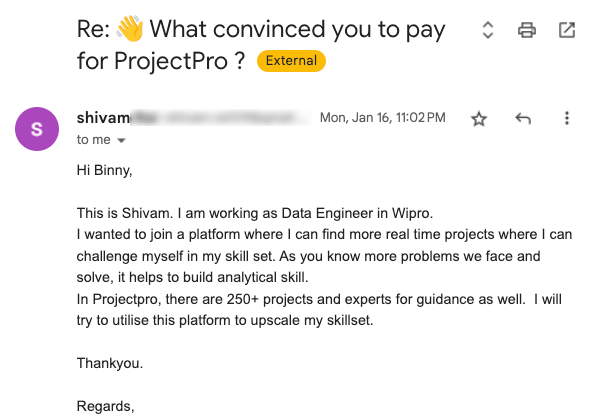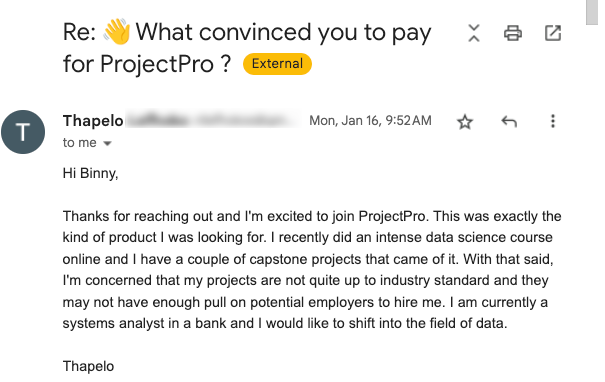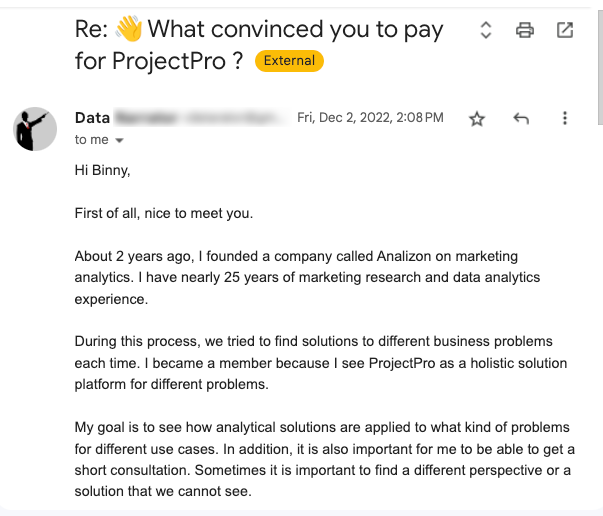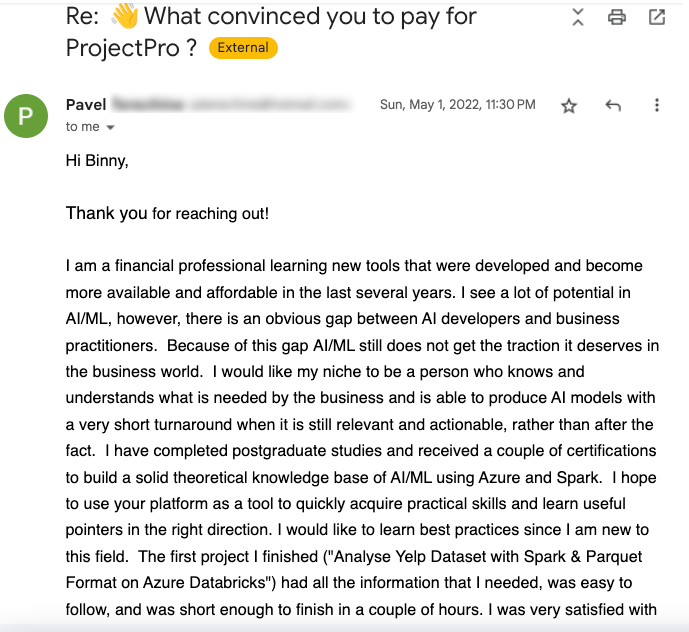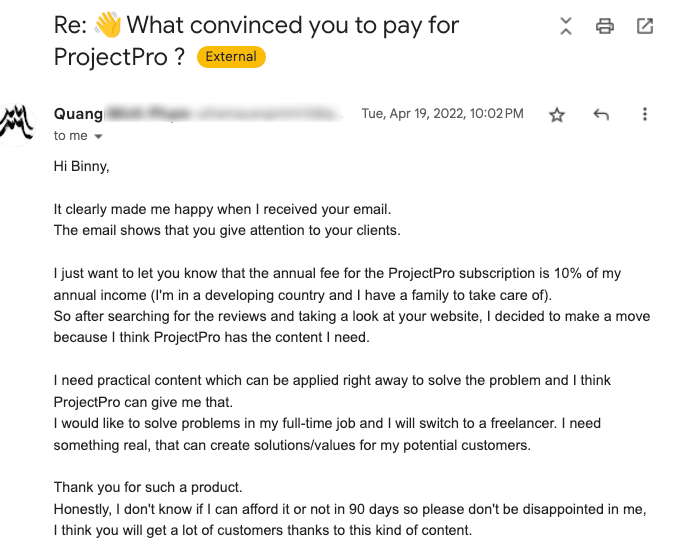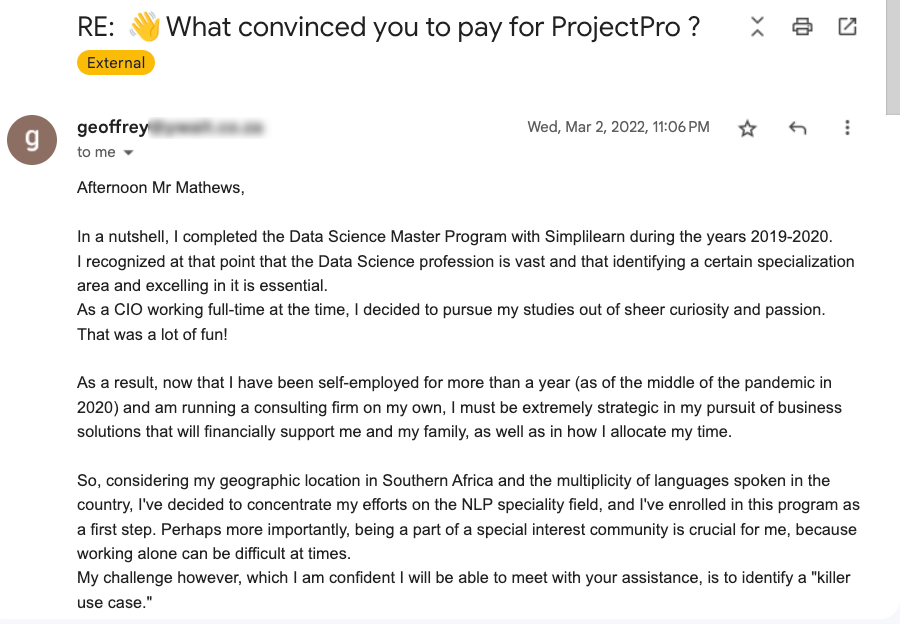
Data Scientist, Inmobi

Principal Software Engineer, Afiniti

Big Data Engineer, Beyond Limits

Chief Science Officer at DataPrime, Inc.
In this machine learning project, you will develop a machine learning model to accurately forecast inventory demand based on historical sales data.
Get started today
Request for free demo with us.
Schedule 60-minute live interactive 1-to-1 video sessions with experts.
Unlimited number of sessions with no extra charges. Yes, unlimited!
Give us 72 hours prior notice with a problem statement so we can match you to the right expert.
Schedule recurring sessions, once a week or bi-weekly, or monthly.
If you find a favorite expert, schedule all future sessions with them.
Source: ![]()
Source: ![]()
Source: ![]()
Source: ![]()
Source: ![]()
Source: ![]()
Source: ![]()
Source: ![]()
Source: ![]()
Source: ![]()
Source: ![]()
Source: ![]()
Source: ![]()
250+ end-to-end project solutions
Each project solves a real business problem from start to finish. These projects cover the domains of Data Science, Machine Learning, Data Engineering, Big Data and Cloud.
15 new projects added every month
New projects every month to help you stay updated in the latest tools and tactics.
500,000 lines of code
Each project comes with verified and tested solutions including code, queries, configuration files, and scripts. Download and reuse them.
600+ hours of videos
Each project solves a real business problem from start to finish. These projects cover the domains of Data Science, Machine Learning, Data Engineering, Big Data and Cloud.
Cloud Lab Workspace
New projects every month to help you stay updated in the latest tools and tactics.
Unlimited 1:1 sessions
Each project comes with verified and tested solutions including code, queries, configuration files, and scripts. Download and reuse them.
Technical Support
Chat with our technical experts to solve any issues you face while building your projects.
7 Days risk-free trial
We offer an unconditional 7-day money-back guarantee. Use the product for 7 days and if you don't like it we will make a 100% full refund. No terms or conditions.
Payment Options
0% interest monthly payment schemes available for all countries.
Demand forecasting, or demand planning process, helps estimate the future customer demand for any product using the available customer data for the product. Demand forecasts are important to the most basic processes in any organization. To plan and deliver products and services is necessary to know what the future might hold. A demand forecasting process is important for all business decisions: sales, finance, production management, logistics, and marketing. To be able to predict the next purchases is a valuable thing for any business. An accurate demand forecasting process can help businesses offer consumers with the right product at the right place and time, which is very important to businesses to get more profit margin.
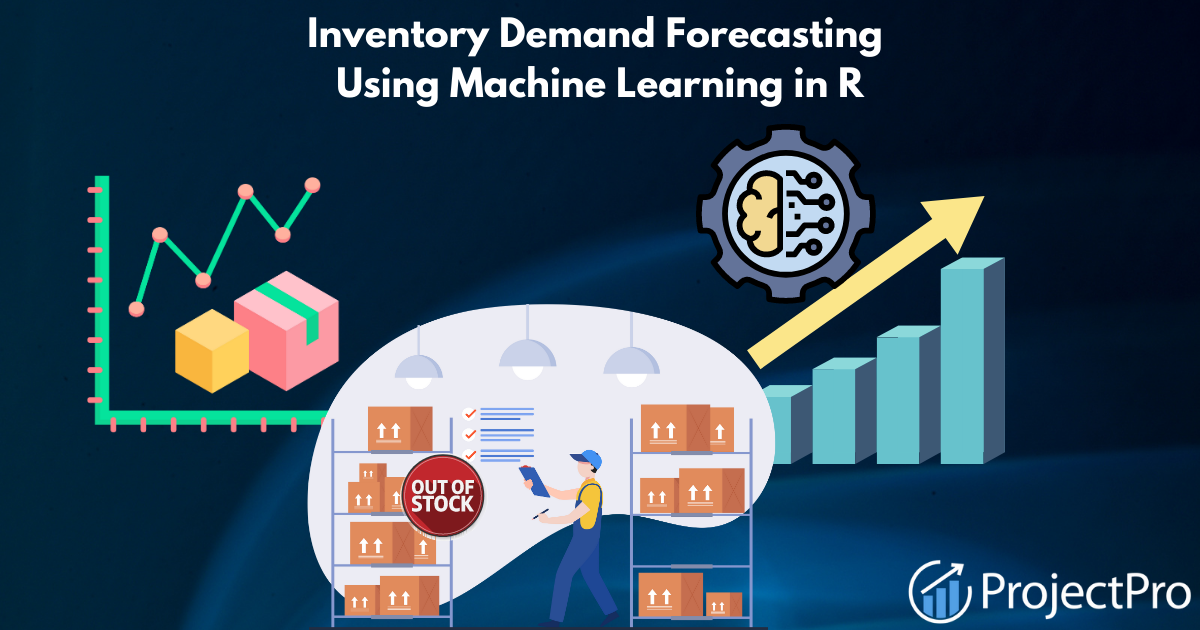
This demand forecasting machine project aims to forecast actual sales and inventory demand using historical data (sales) of Grupo Bimbo bakery products in R.
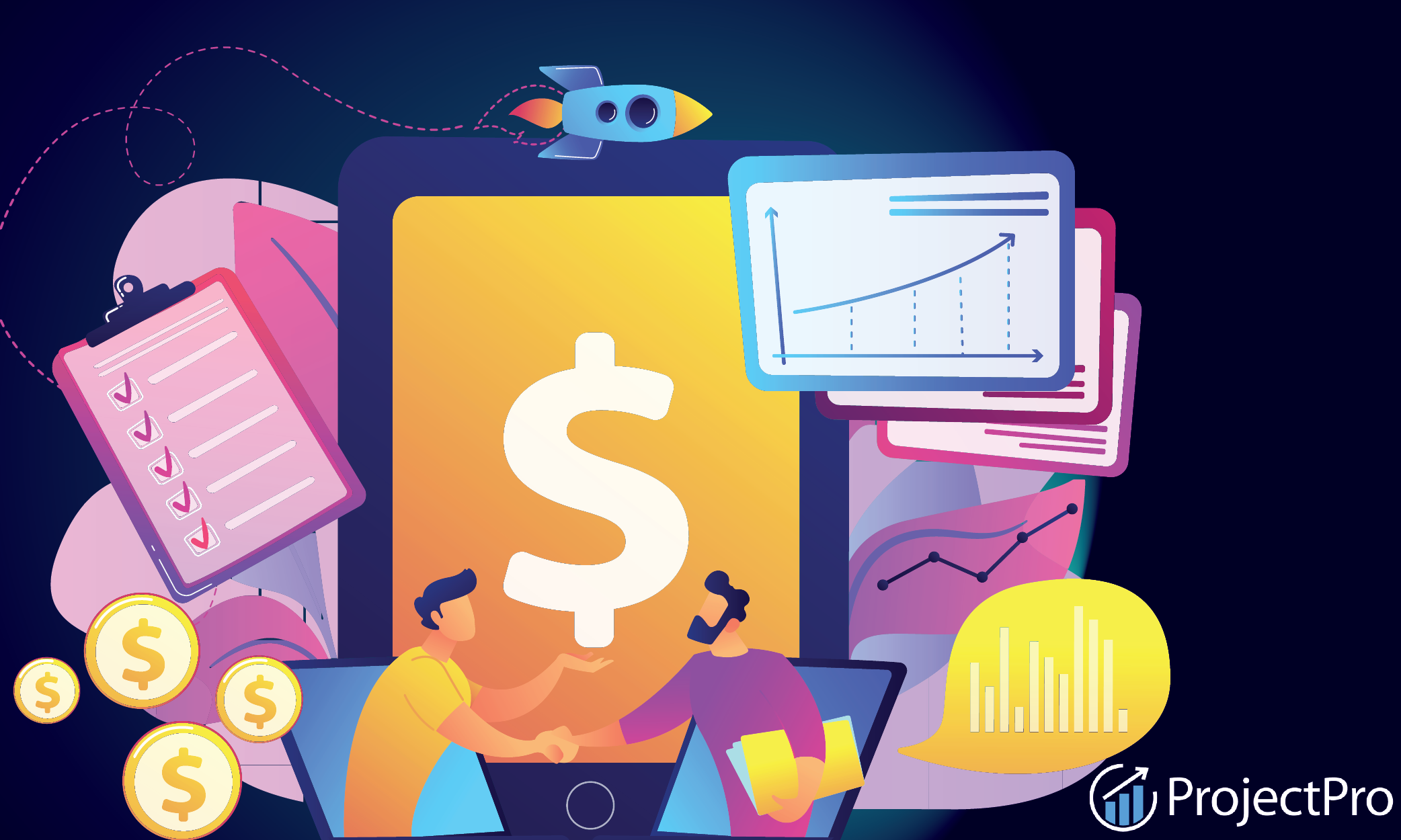
The demand forecasting dataset used for this project is from the Mexican multinational company Grupo Bimbo. The delivery chain is present in countries in America, Europe, Asia, and Africa.
Language: R
Libraries: dplyr, ggplot2, caTools, xgboost, data.table, Matrix, lightgbm, gbm, caret, zoo, DataCombine, e1071
Here are the key learning takeaways from the Inventory Demand Prediction ML project-
You will understand the business problem, i.e., how to predict inventory demand for a multinational company and how to use a data science approach to solve the problem. You will understand why a typical time series model is not ideal for solving such business problems and how you can implement Regression-based models to build such solutions.
You will learn how to perform basic data cleaning and EDA on the given dataset to determine any missing values and inconsistencies in it. You will also learn how to analyze the dataset to determine the relationship between the attributes, hidden insights/patterns within the data, etc. You will also learn how to perform feature engineering on the dataset to prepare it for building the predictive model.
You will learn how to split the dataset into training and testing data for model validation and also explore the concepts of bagging and boosting in machine learning. You will be introduced to the various evaluation metrics, such as Mean Absolute Deviation, Mean Square Error, Root Mean Square Error, etc., and how to use these metrics for evaluating machine learning model performances.
Working on this ML forecasting project in R will help you understand how various ML models, such as XGBoost, GBM and LightGBM, SVM, and deep learning models like LSTM, work and how to build and hyper-tune these models according to the required solution.
This inventory demand forecasting machine learning project involves various data science and machine learning forecasting methods and approaches, which are discussed below-
You will work with the Grupo Bimbo dataset for demand forecasting in this ML project. The Grupo Bimbo dataset for demand forecasting is publicly available and provided by Grupo Bimbo, a Mexican bakery product manufacturing company. The dataset was released as part of a Kaggle competition called "Grupo Bimbo Inventory Demand," which aimed to predict the demand for various bakery products at different locations and dates. The dataset has an annual sales volume of 15 billion dollars. Grupo Bimbo delivers fresh bakery products to 1 million stores along its 45,000 routes across Mexico.
The dataset contains historical sales data for different products across various distribution channels. It includes product attributes (e.g., weight, brand), client demographics, sales volume, and dates. This project aims to develop accurate machine learning models that could predict product demand for future periods, enabling Grupo Bimbo to optimize its inventory management and production planning.
Before you start working on this project, you must load the required dataset and explore the attributes present to better understand the dataset structure.
There are five files available within this dataset-
train.csv- It contains data available for training. The dataset contains about 7.4 billion entries over 11 features.
train.csv- It contains data available for testing.
cliente_tabla.csv- It contains the data of 93 million clients over 2 different features.
producto_tabla.csv- It contains the data for 2592 products.
town_state.csv- It contains the data for 790 towns

Once you import the dataset, the first step is to check the dataset for any missing values or inconsistencies. In this case, there are no missing values, but there are a few inconsistencies, for instance, the use of special characters in the State column). You will use a function to replace these special characters with actual English alphabets. This demand forecasting solution also involves performing EDA to determine the top-performing products, i.e., which products have the highest sales and demand, and obtain an aggregate result to view the top five products in sales and demand. It also involves analyzing weekly product sales and demand trends along with the top vendor agencies.

Before splitting the demand forecast dataset into training and testing data, this demand forecast ML project uses feature engineering to create more meaningful features in the external data that can act as exogenous factors while building the regression forecasting model. It first converts the numerical features (Agency_Id, Product_Id, etc.) from external data sources into factors so that the ML algorithm knows what kind of variable it is. Furthermore, it involves creating ‘Lag features’ by grouping the data by agencies and products.
Machine learning algorithms can automatically learn patterns and relationships from any given data and, thus, generate reliable forecasts and insights. Popular machine learning algorithms include decision trees, support vector machines, logistic regression, random forests, gradient boosting, and deep learning models like neural networks. By leveraging these algorithms, data scientists can build predictive models that can classify, regress, cluster, or recommend, allowing them to solve various prediction tasks in fields like finance, healthcare, marketing, etc.
This ML demand forecast project uses various ML algorithms, such as XGBoost, GBM, SVM, etc., to build predictive models. Let us understand how this project uses each of the ML algorithms to predict future demand in more detail.
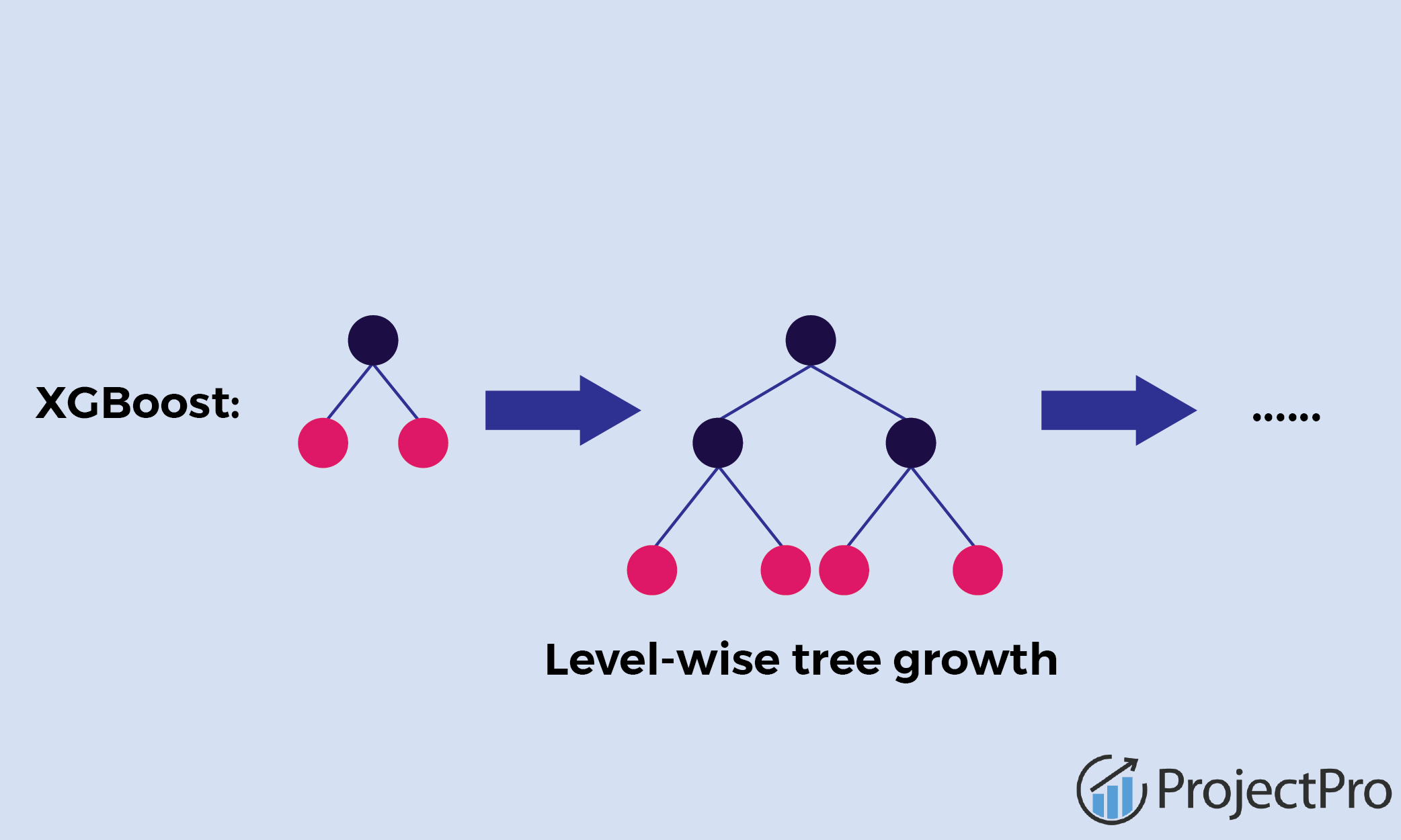
This data science project code includes a built-in cross-validation method, ‘cv’, that allows the user to run cross-validation at each iteration of the boosting process. This makes getting the exact number of boosting iterations in a single run easier. Also, the code involves using specific parameters (max_depth, gamma, subsample, etc.) to build the XGBoost forecasting model.
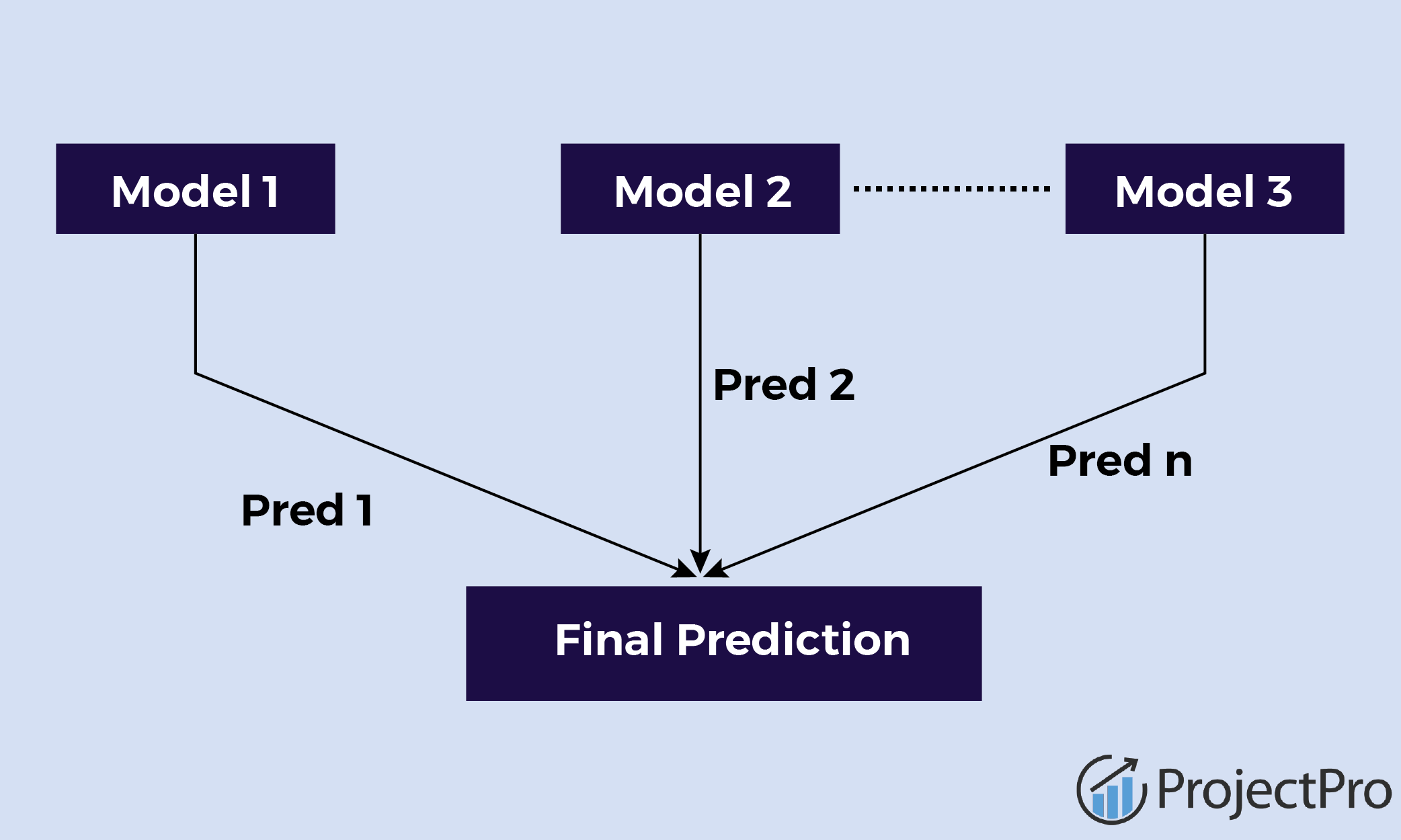
The project code involves installing and invoking the GBM libraries. Next, we will train the GBM model on the sample dataset using parameters such as n.trees, shrinkage, etc., and tune these parameters using GridSearch. We will employ the ‘predict’ function to make predictions on the test dataset and calculate the Root Mean Square Error (RMSE).
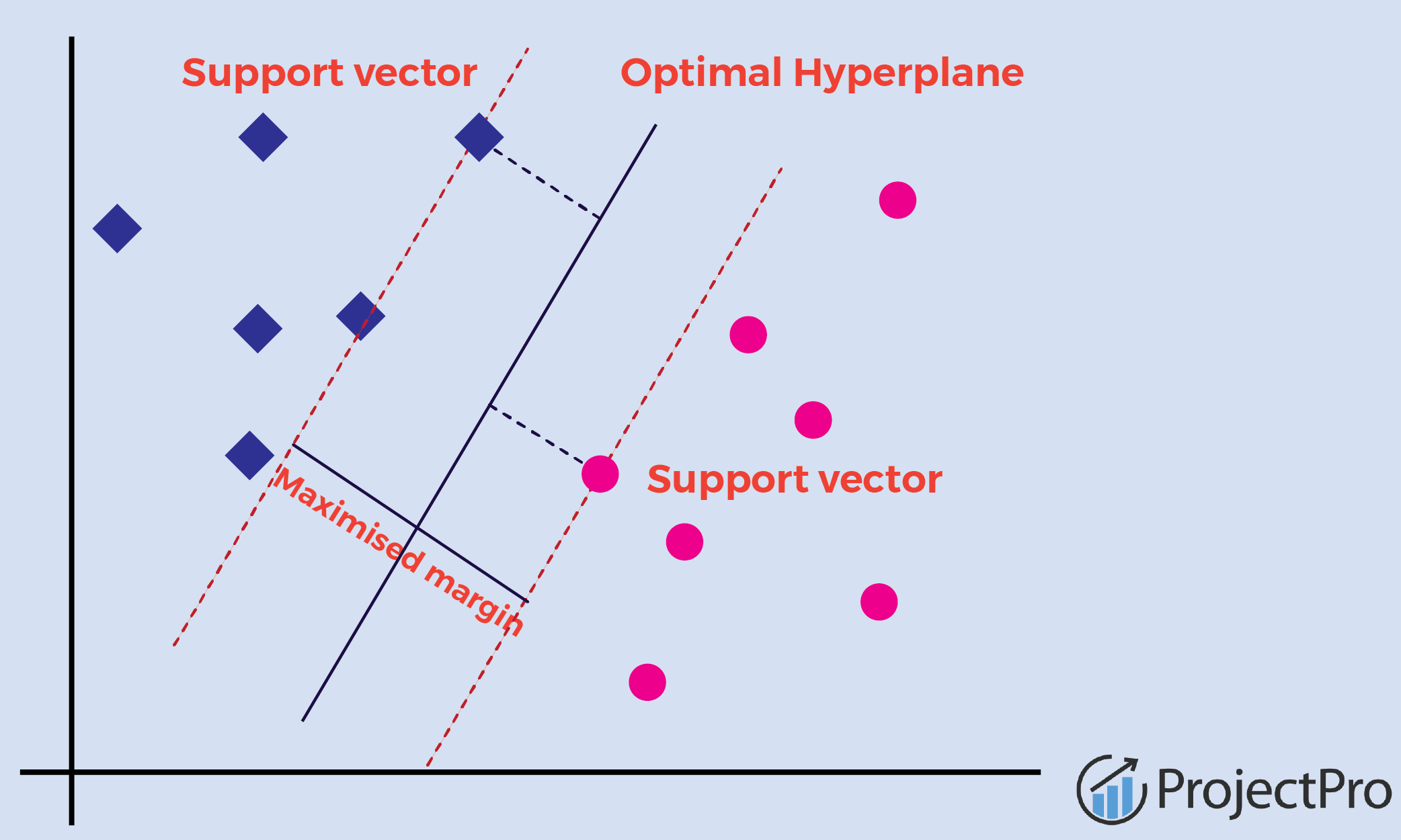
We will import the required SVM library and select a few relevant columns in the training dataset to perform regression on those columns using a basic SVM linear model.
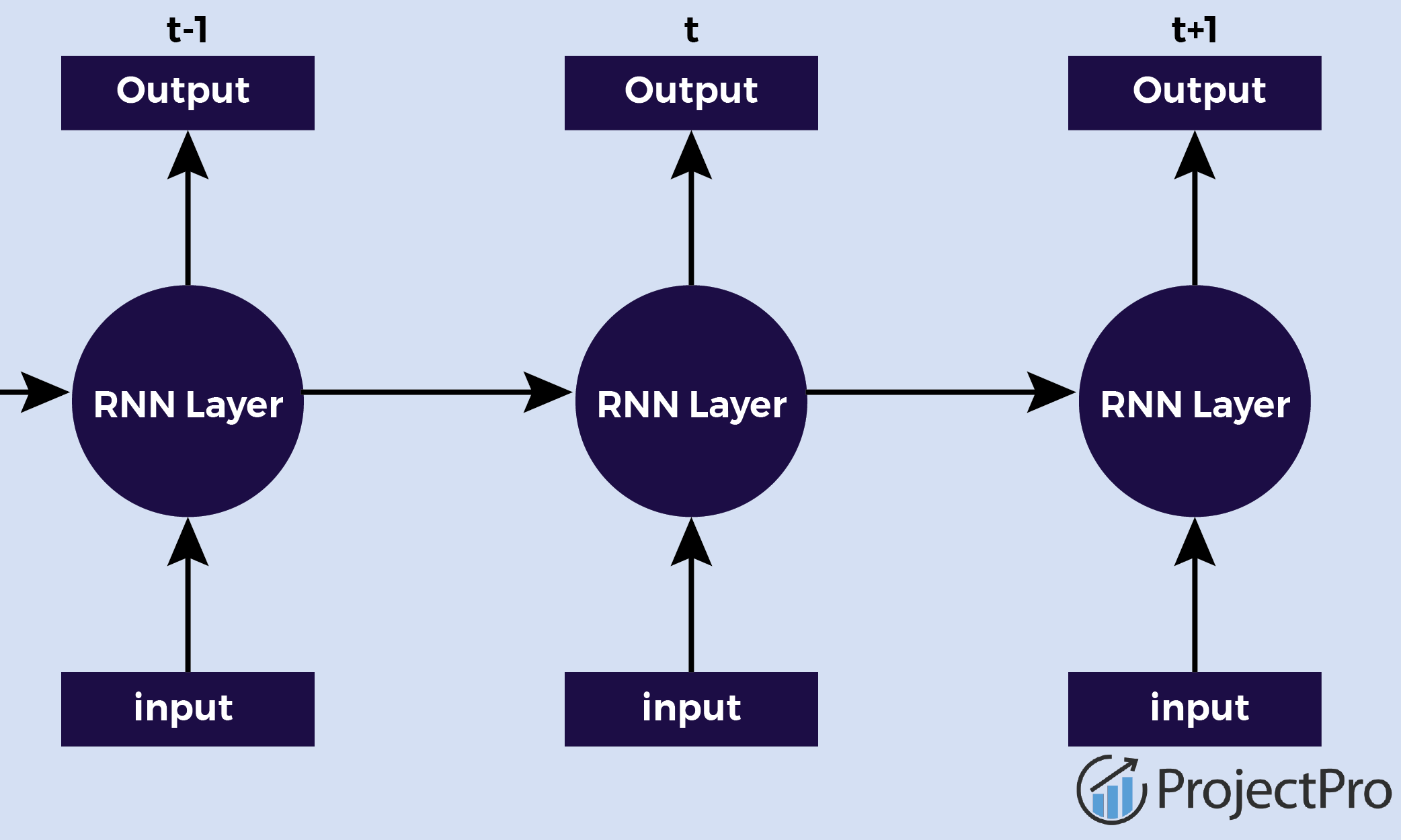
We will use a multilayered LSTM RNN to predict the last value of a sequence of the values. The model considers multiple instances of the previous day to have the value of the last occurrence as the target variable. We will normalize the data before fitting the model and then boost the performance of the LSTM model.
Exploratory data analysis (EDA)
Data visualization
Inference about features
Feature engineering
Data cleaning (outlier/missing values/categorical)
Missing value detection
Replacing special characters in data
Feature Engineering
Adding lag columns for target variable
Adding moving average columns for target variable
Model building on training data
XGBoost
GBM
SVM
Model validation
RMSE
Conclusion
Demand forecasting using machine learning and artificial intelligence is highly useful for businesses. Imagine having the power to accurately predict future demand for your products or services. It's like having a crystal ball that allows you to optimize every aspect of your business operations. By analyzing historical data, real-time market insights, and other useful business tools, machine learning algorithms become your secret weapon. They generate accurate demand forecasts, enabling you to plan your resources, manage inventory, and allocate them efficiently. This means you can minimize costs, boost customer satisfaction, boost overall revenue, and, most importantly, meet consumer demand without running out of stock! You can think of it as having a trusted advisor who helps you navigate the dynamic customer demands and ensures your business thrives compared to its competitors!
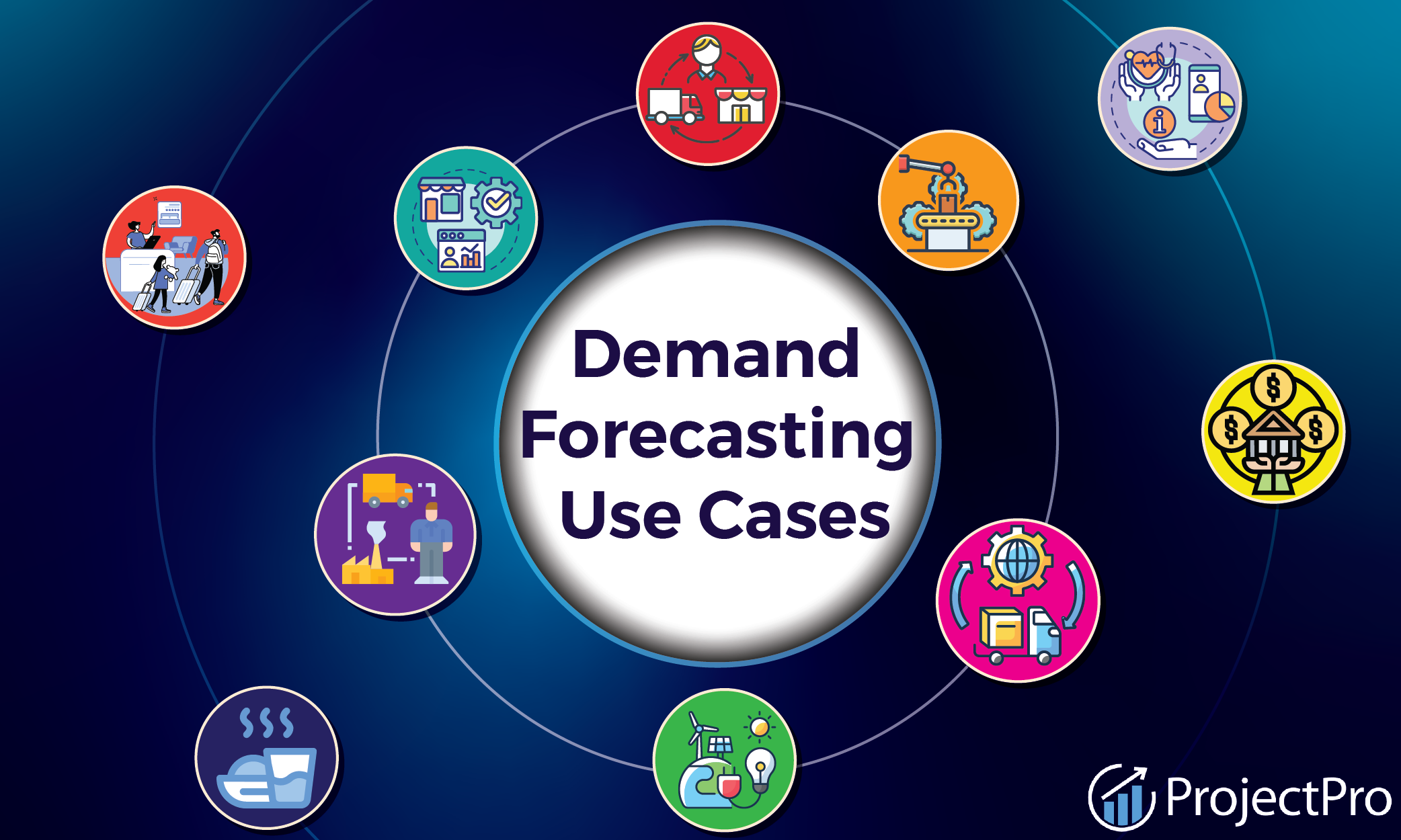
Below are some common use cases of demand forecasting models using machine learning tools across various industries.
Retail Industry- In retail demand forecasting, machine learning helps retailers predict consumer demand for different products, optimizing inventory levels and improving supply chain efficiency.
E-commerce Industry- In e-commerce demand forecasting, machine learning enables online platforms to anticipate customer preferences, optimize product recommendations, and manage inventory effectively.
Manufacturing Industry- ML forecasting models can forecast demand for raw materials, enabling manufacturers to streamline procurement, production, and inventory management processes.
Transportation And Logistics- Demand forecasting helps logistics companies optimize routes, allocate resources efficiently, and plan for peak demand periods to ensure timely delivery.
Energy Sector- In energy demand forecasting, machine learning forecasting methods assist in predicting electricity demand, facilitating efficient generation, distribution, and pricing strategies while supporting renewable energy integration.
Hospitality And Tourism- Demand forecasting allows hotels and travel agencies to predict seasonal fluctuations, optimize pricing strategies, and allocate resources effectively to meet customer demands.
Supply Chain Management- In supply chain demand forecasting, machine learning helps businesses optimize their supply chain by predicting demand patterns, reducing lead times, and minimizing stockouts.
Healthcare Industry- Demand forecasting assists healthcare providers in predicting patient admissions, optimizing resource allocation, and planning for medical supplies and equipment.
Financial Organizations- ML models help predict market demand for financial products, such as insurance policies or investment options, helping financial institutions optimize their financial planning or pricing strategies.
Food And Beverage Industry- Demand forecasting assists restaurants and food service providers in managing inventory levels, reducing waste, and meeting customer demands during peak hours or events.
Let us look at a few real-world examples of Demand Forecasting using Machine Learning across various organizations-
Amazon- Have you ever wondered how e-commerce giants like Amazon offer such a huge variety of products and services to their customers, maintain sufficient stocks, and meet such varying customer demands- simultaneously? The answer is- by implementing ML algorithms. Amazon utilizes machine learning for demand forecasting to optimize inventory management and ensure timely delivery of products across its vast e-commerce platform. By analyzing historical data, market trends, and customer behavior, Amazon can generate accurate predictions for future demand. This allows the e-commerce company to stock the right products in the right quantities, minimize stockouts, and ensure timely delivery, thus, enhancing the overall customer shopping experience.
Walmart- Walmart leverages machine learning algorithms to forecast demand for various products, enabling efficient inventory planning and reducing stockouts in its retail stores. By utilizing machine learning techniques, Walmart can analyze vast amounts of historical sales data, external factors, and market trends to forecast customer demand accurately and provide a seamless shopping experience to its customers.
Uber- Machine learning allows Uber to analyze vast amounts of historical trip data, along with real-time factors such as location, time of day, and events, to predict rider demand accurately. This enables them to optimize driver allocation, reduce waiting times, and ensure efficient transportation services. No wonder Uber has become one of the most popular ride-hailing services among individuals worldwide!
Airbnb- Airbnb, the popular online marketplace for vacation rentals, employs machine learning models to forecast demand for vacation rentals in different regions. Airbnb uses ML techniques to analyze historical booking data, pricing patterns, seasonality, and other factors to predict demand for vacation rentals in different regions. This enables hosts to optimize their pricing strategies, manage availability, and attract more guests during peak periods. So, the next time you book an Airbnb for your vacation, you know how it offers you such amazing and ideal options on such short notice!
Tesla- You must have heard of Tesla- the innovative electric vehicle manufacturer in the world! Tesla utilizes machine learning algorithms to forecast demand for its electric vehicles, enabling efficient production planning and managing supply chain logistics. By analyzing historical sales data, market trends, and other factors like environmental policies, etc., Tesla's machine learning models can predict customer demand for electric vehicles, help streamline production processes, manage inventory efficiently, and ensure timely deliveries to meet customer orders.
Several types of machine learning models are used in demand forecasting systems, including time series models (such as ARIMA and SARIMA), regression models (such as linear regression), ensemble methods (such as Random forest), and deep learning models (such as recurrent neural networks).
Yes, machine learning is good for forecasting as it can analyze large amounts of data, identify patterns, and generate predictions based on historical and real-time data. Machine learning models can provide more accurate forecast, helping businesses optimize their business operations, make better strategic decisions, and improve overall efficiency.
To forecast demand using a machine learning system, follow these steps:
You must collect relevant data on past demand, including sales, customer behavior, market trends, and external factors.
The next step involves cleaning the data, handling missing values, and transforming it into a suitable format for analysis.
Then, you must choose a model based on the nature of your data and problem, such as time series models (ARIMA, SARIMA), regression models, ensemble methods, or deep learning models.
Next, you must divide the data into training and testing sets, ensuring the model is trained on past data and evaluated on new data.
You must fit the selected model to the training data, adjusting hyperparameters and optimizing performance through techniques like cross-validation.
Next, you must evaluate the model's performance on the testing data using metrics like mean absolute error (MAE), mean squared error (MSE), or accuracy.
Then, you will deploy the trained model to forecast future demand based on new inputs, considering market dynamics and other relevant factors.
You must continuously monitor the model's performance and update it periodically using new data to enhance forecast accuracy and adapt to changing demand patterns.
Recommended
Projects
5 Top Machine Learning Projects using KNN
Explore the application of KNN machine learning algorithm with these machine learning projects using knn with source code.
How to Learn Airflow From Scratch in 2024?
The ultimate curated collection of premier resources tailored to guide you to learn Apache Airflow from the ground up in 2024. | ProjectPro
Feature Scaling in Machine Learning: The What, When, and Why
Enhance your knowledge of feature scaling in machine learning to refine algorithms, learn to use Python to implement feature scaling, and much more!
Get a free demo







